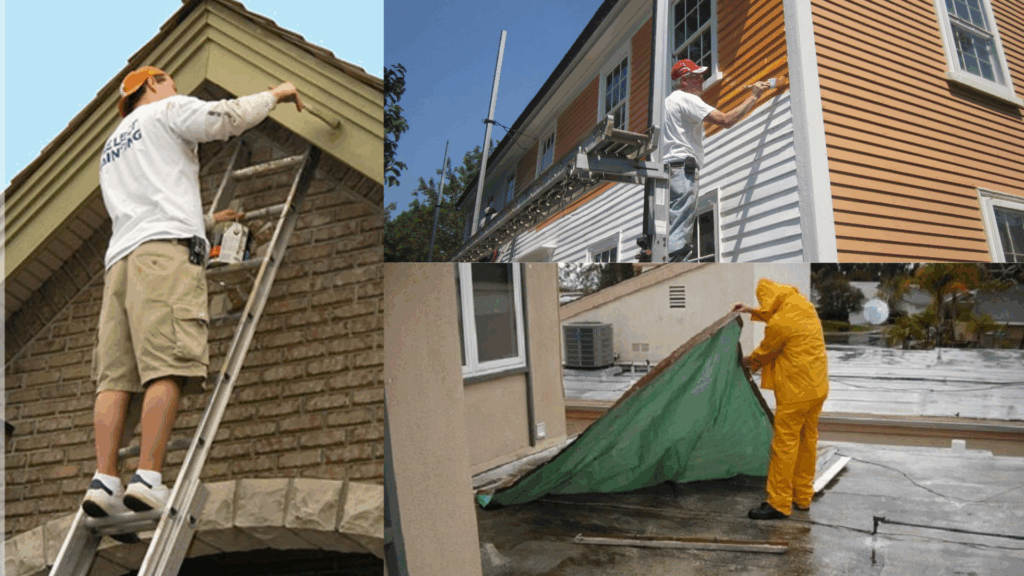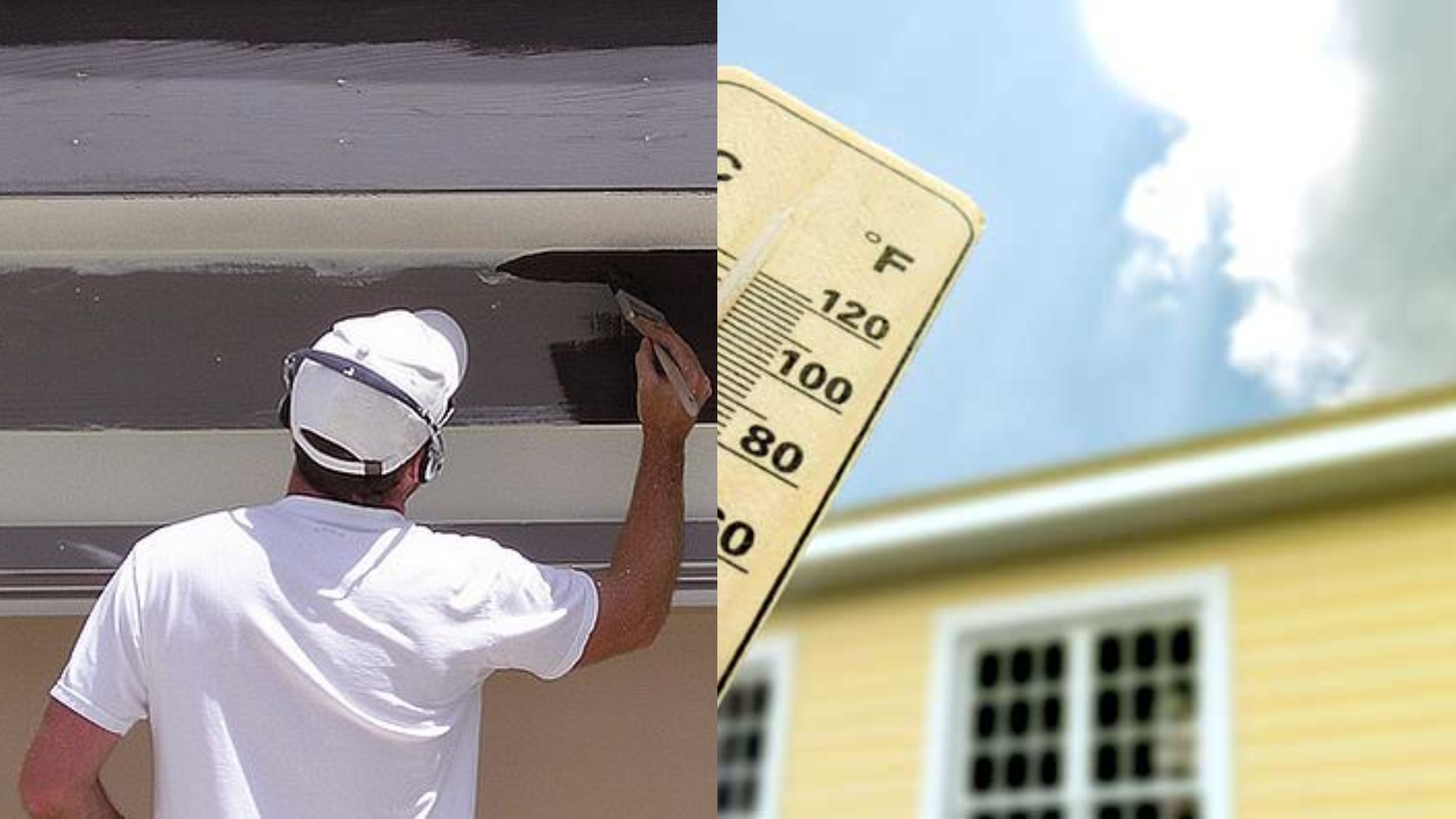I’ve learned through experience that timing can make or break an exterior painting job.
It’s not just about picking a sunny day; things like temperature, humidity, wind, and even the time of day all play a role in how well the paint sticks and dries.
I once painted too early in the morning and ended up with streaks from overnight dew. Another time, I painted in direct sunlight, and the finish dried too fast, leaving roller marks.
These weren’t just minor hiccups; they cost time, money, and effort to fix. That’s why I always check the full forecast before I even open a paint can. In this blog, I’ll go over all the times it’s smarter to hit pause on your painting plans.
Why Should Weather Guide Your Painting Schedule?
When starting out with exterior painting projects, it’s easy to underestimate how much the weather can influence the final result.
Temperature, humidity, and precipitation don’t just affect drying time; they determine how well the paint adheres, how smoothly it goes on, and how long it lasts.
Cold weather can stop paint from curing properly, leading to cracking or peeling within weeks. Extreme heat may cause it to dry too fast, leaving behind streaks or roller marks.
High humidity traps moisture beneath the surface, increasing the risk of bubbling and blistering. Even small shifts, like a sudden drop in temperature overnight, can undo an entire day’s work.
Watching the weather forecast isn’t just helpful; it’s critical to achieving a long-lasting, professional-looking finish.
When Not to Paint Outside?

Knowing when to avoid painting your home’s exterior can save you from costly mistakes, poor finishes, and wasted effort.
1. Extreme Temperatures
Painting in extreme temperatures can compromise the finish and durability of exterior paint. When it’s too cold, paint doesn’t cure properly and can peel or crack within days.
On hot days, the paint dries too fast, causing roller marks, air bubbles, and uneven texture.
The ideal temperature range for painting is between 60°F and 85°F, with consistent weather conditions to allow for even drying and proper adhesion.
2. High Humidity
High humidity affects both the drying time and adhesion of exterior paint. Moisture in the air prevents paint from setting correctly, often resulting in bubbling, blistering, or peeling.
It also keeps the surface damp longer, making it difficult for paint to bond. Humidity above 70% increases the risk of imperfections and delays drying.
Waiting for a dry day with moderate humidity ensures smoother results and longer-lasting protection.
3. Rainy Conditions
Painting during or just before rain can instantly ruin a fresh coat. Rain washes paint away, leaving streaks and bare patches.
Even if the rain holds off, high moisture levels in the air or on the surface can seep into the paint, causing peeling and discoloration later.
It’s best to avoid painting if rain is expected within 24 to 48 hours to ensure proper curing and a clean finish.
4. Windy Days
Strong winds can cause major issues when painting outside. The wind carries dirt, dust, and debris that can stick to wet paint and ruin the finish.
It also speeds up drying in some areas, while others remain wet, resulting in an uneven, patchy appearance. Gusts can blow tools or even paint off course, making the process messier and more difficult.
Calm, still conditions are ideal for exterior painting.
5. Direct Sunlight
Direct sunlight may seem perfect for drying paint, but it actually causes problems. The heat speeds up drying too much, leading to brush marks, lap lines, and an uneven surface.
It can also cause paint to become tacky and harder to apply evenly. Over time, UV rays can fade the paint color faster. It’s better to paint shaded areas or follow the sun’s path around the house.
6. Dew and Moisture
Morning dew leaves a thin layer of moisture that may not be visible but can affect paint adhesion. Painting over dew-soaked surfaces often leads to peeling, bubbling, or a patchy finish.
Even light moisture can delay drying times and weaken the final result. Wait until the surface is fully dry, typically late morning, to start painting, especially after cool, damp nights or early morning fog.
7. Seasonal Considerations
Each season brings specific challenges for exterior painting. Winter’s cold temperatures and potential frost prevent proper curing, leading to brittle finishes.
Summer’s intense heat can cause quick drying and visible application flaws. Spring and early fall usually provide more stable weather, with mild temperatures and lower humidity.
Planning around seasonal conditions helps achieve better results, reduce do-overs, and extend the life of the paint job.
8. Poor Surface Preparation
Painting over dirty, greasy, or chalky surfaces weakens adhesion and leads to early paint failure. Cracks, holes, or peeling paint need to be cleaned and repaired before applying a new coat.
Skipping these steps results in uneven coverage and shortens the paint’s lifespan. Proper surface preparation, like washing, scraping, patching, and priming, is essential for a smooth, professional finish that holds up over time.
9. Inadequate Lighting
Poor lighting can make it hard to see areas that have already been painted, leading to missed spots, uneven layers, or roller lines. It can also affect how the color appears, making it look different once the paint dries.
Painting when the lighting is low, such as early morning or late afternoon, often results in inconsistent coverage. Natural, even daylight ensures accuracy and a more uniform appearance.
How to Read Weather for Paint Projects?
Checking the forecast isn’t enough; understanding key weather factors can help ensure your paint job lasts and looks great.
- Check temperature range, not just daytime highs: Ideal painting temperatures are usually between 60°F and 85°F, including overnight lows.
- Watch for sudden temperature drops: A sharp drop after sunset can prevent proper curing, even if the daytime is warm.
- Monitor humidity levels: Aim for humidity under 70% to avoid slow drying, bubbling, or poor adhesion.
- Look for a 2–3 day dry stretch: Paint needs time to cure, so check for at least 24–48 hours with no rain in the forecast.
- Pay attention to dew points: If the dew point is close to the actual temperature, surfaces may remain damp even if it’s not raining.
- Avoid windy conditions: Even light wind can carry dust and debris that ruin a clean finish or cause uneven drying.
How Long Does it Take Paint to Dry Outdoors?
Outdoor paint generally dries to the touch within 1 to 2 hours, but full drying and curing take much longer.
Depending on the type of paint, temperature, humidity, and surface material, complete curing can take anywhere from 24 hours to 30 days.
Latex paint tends to dry faster than oil-based options, especially in warm, dry, and well-ventilated conditions. Cooler temperatures, high humidity, or painting in shaded areas can significantly slow the process.
Most paint manufacturers recommend waiting at least 4 to 6 hours between coats and checking for product-specific guidance on recoat and cure times.
Allowing proper drying time prevents issues like bubbling, peeling, or streaking and ensures a smooth, durable finish.
For best results, avoid painting if unfavorable weather is expected within 24 hours of application. Patience leads to better, longer-lasting results.
Common Exterior Painting Myths That Lead to Mistakes
Believing common painting myths can lead to costly errors, poor finishes, and short-lived results when working on exterior surfaces.
- Sunlight helps paint dry faster: While it may dry the surface quickly, it often causes uneven drying and brush marks.
- Any warm day is good for painting: High heat can cause premature drying, leading to cracking and adhesion issues.
- Paint can be applied over dirty walls: Dirt, chalk, or mildew prevent proper adhesion and shorten the paint’s lifespan.
- More coats always mean better durability: Without proper prep or dry time between coats, added layers can actually trap moisture.
- Rain won’t matter once the paint feels dry: Paint may feel dry to the touch but still be vulnerable to moisture damage if not cured.
- Wind helps paint dry faster: Wind often causes debris to stick to wet surfaces and can lead to patchy, uneven drying.
Conclusion
Timing is everything when painting the exterior of a home. After learning the hard way, I now know that ignoring the weather forecast can ruin what could’ve been a smooth, lasting project.
Extreme heat or cold, high humidity, wind, and even early morning dew can all lead to peeling, cracking, or uneven results. It’s not just about a fresh coat; it’s about getting the job done right so it lasts.
I always wait for the right conditions: mild temperatures, dry surfaces, and a clear forecast for at least two days. That simple step has saved me time, money, and frustration.
If you’re preparing for an exterior paint job, take the time to plan ahead and paint when conditions are ideal. Need help figuring out if it’s the right time to start?
Feel free to reach out or drop a comment; I’m always happy to help you make the smart call.
Frequently Asked Questions
Can I paint outside if the weather is cloudy?
Yes, cloudy weather is generally fine as long as there’s no rain or high humidity. In fact, overcast conditions can be ideal since they prevent direct sunlight from drying the paint too quickly.
How long should I wait after the rain before painting?
Wait at least 24 to 48 hours after rain to ensure the surface is completely dry. The drying time may vary depending on temperature, humidity, and the type of material being painted.
What happens if I paint when it’s too cold?
Painting in temperatures below 50°F can lead to poor adhesion, cracking, or peeling. Paint may also take longer to dry and fail to cure properly, resulting in a finish that doesn’t last.
Is it okay to paint in direct sunlight?
Direct sunlight can cause paint to dry too fast, leading to lap marks and an uneven finish. It’s best to paint in shaded areas or follow the shadow line around the house.

